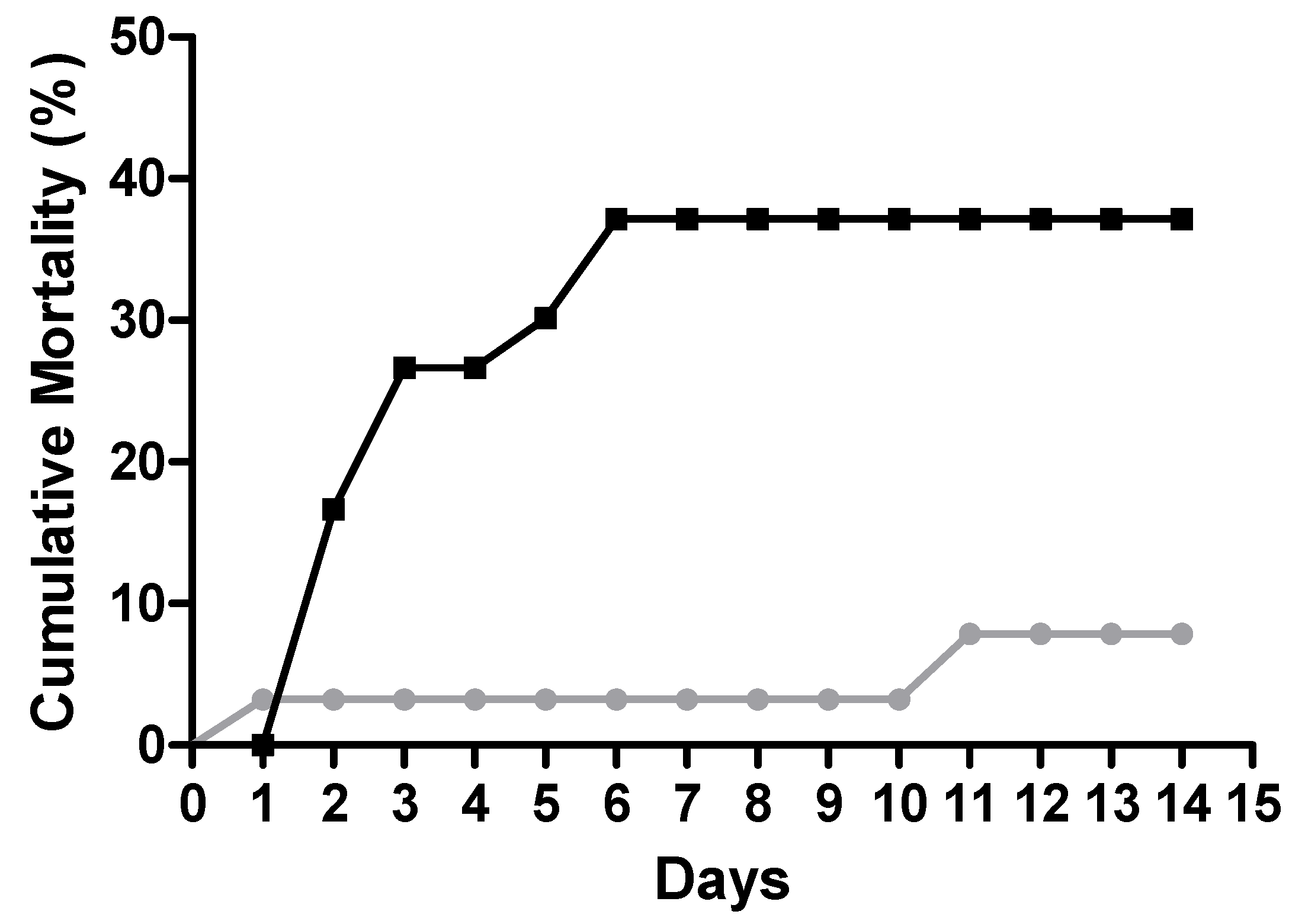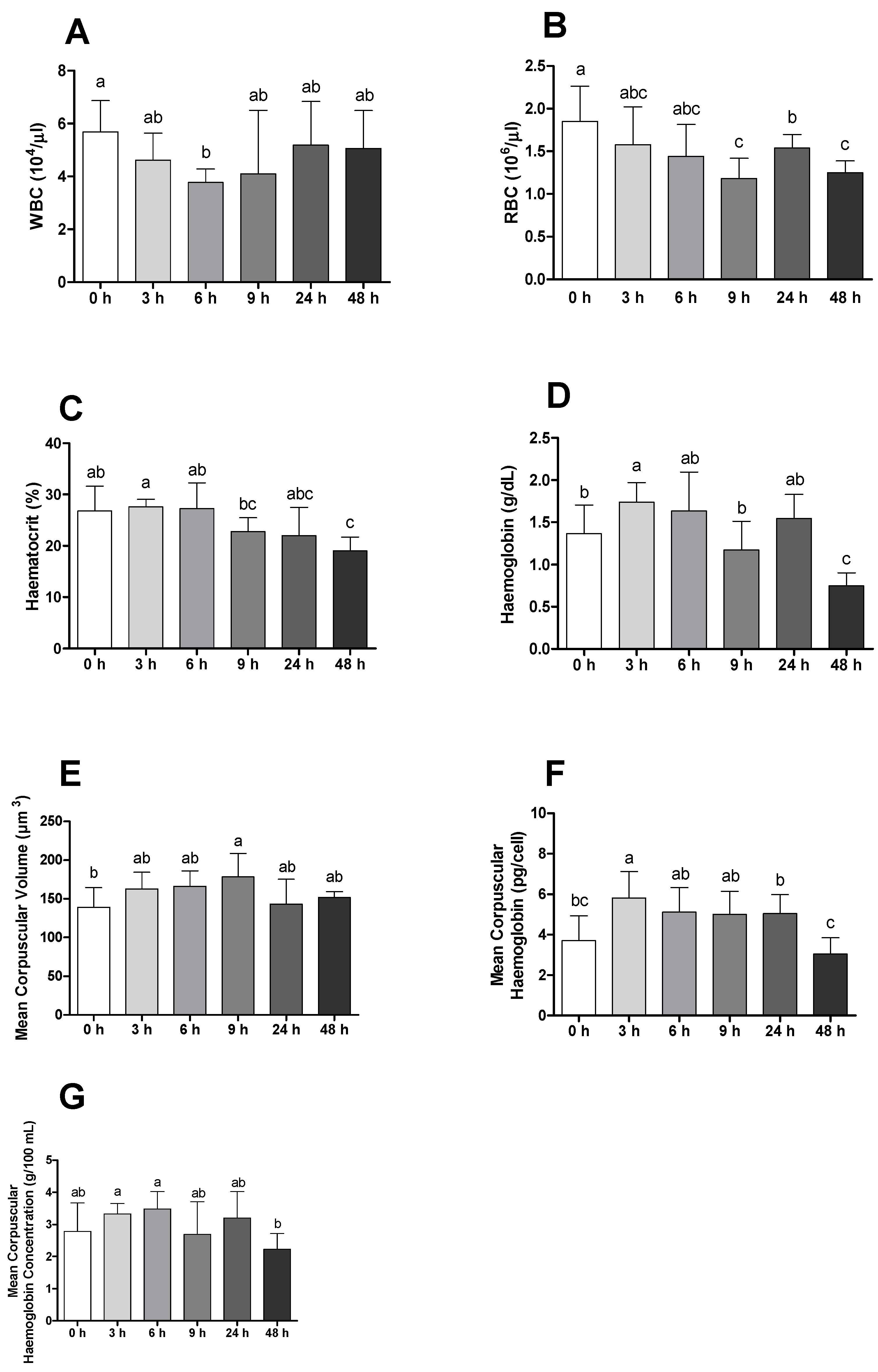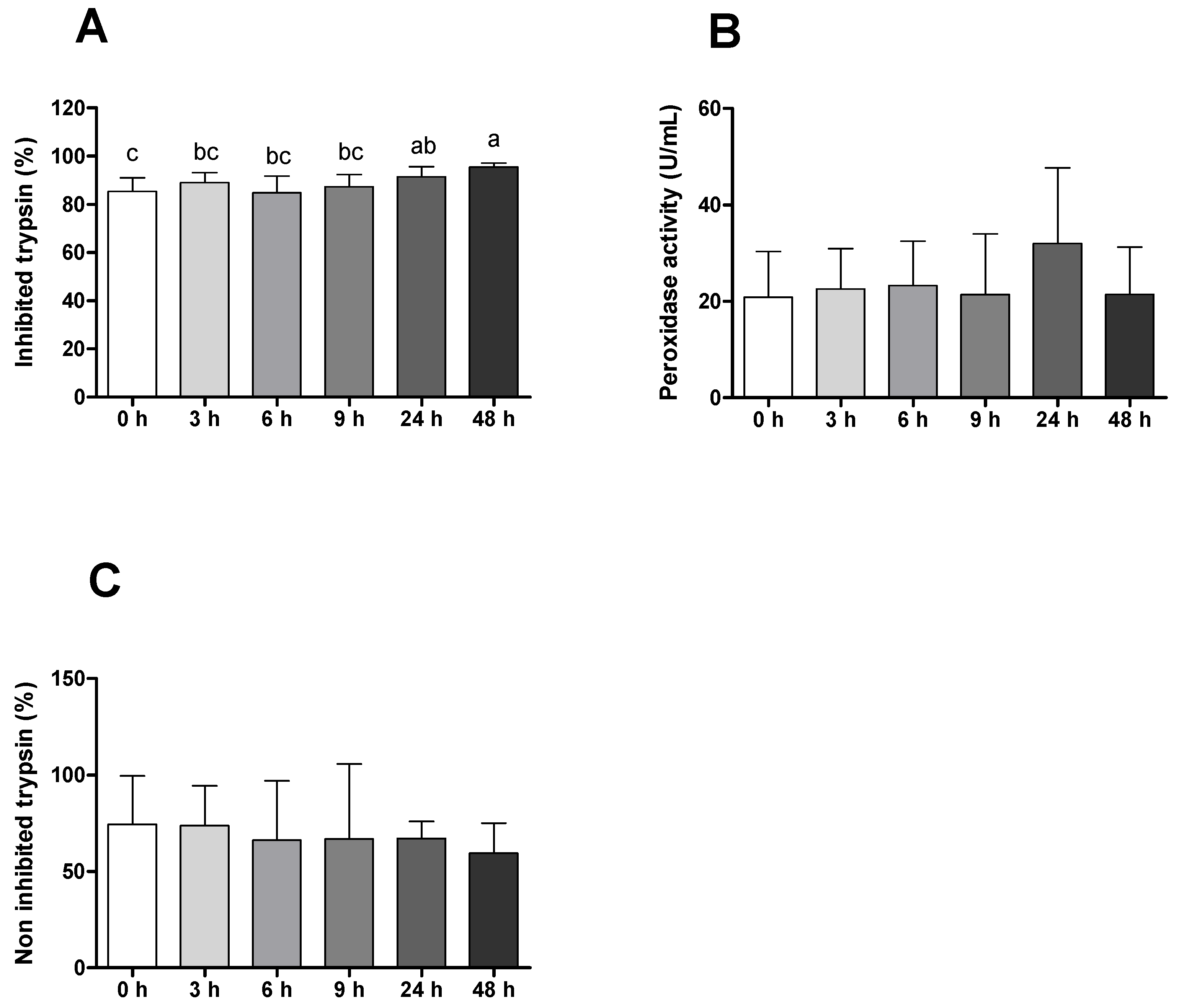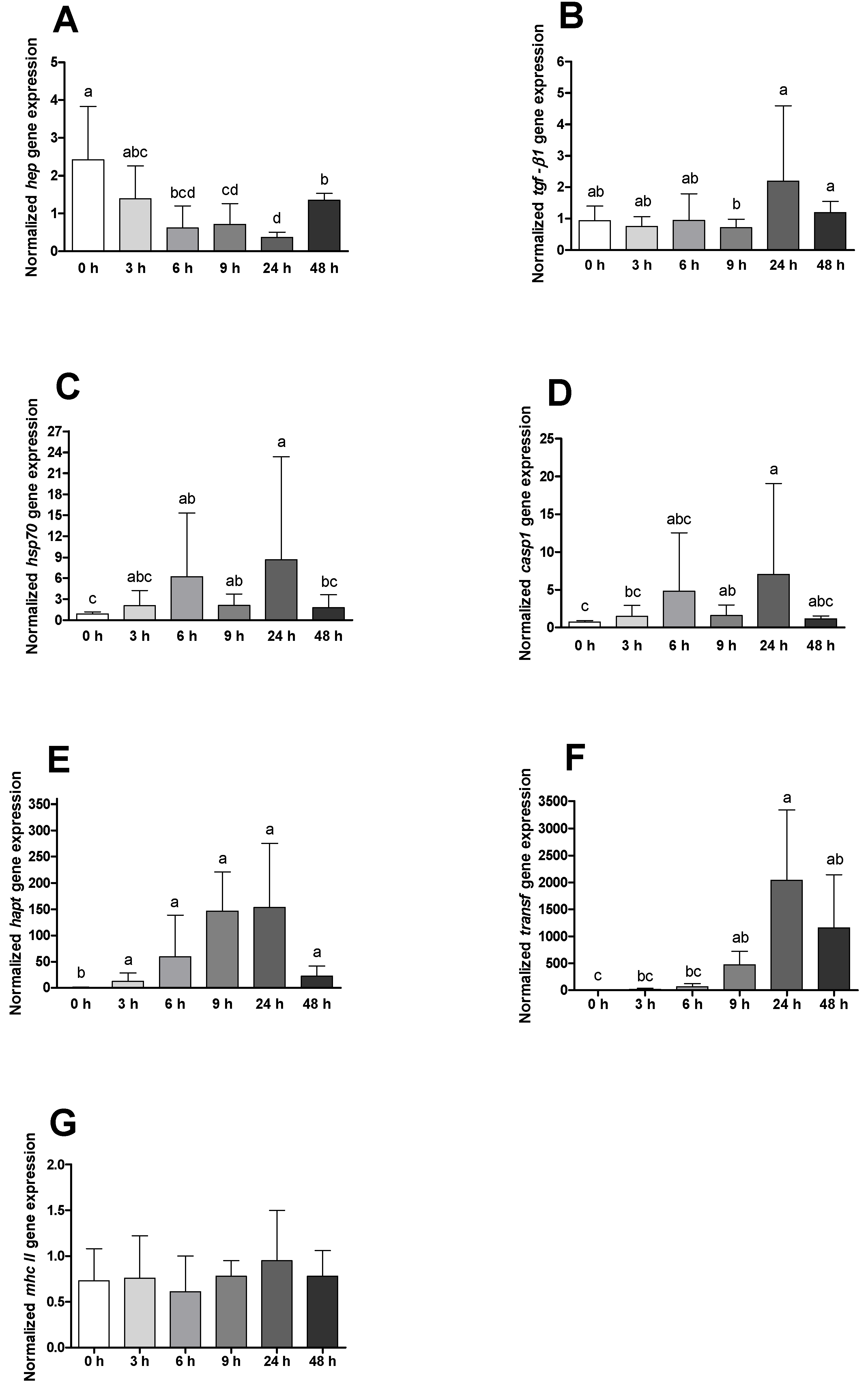Short-Term Immune Responses of Gilthead Seabream (Sparus aurata) Juveniles against Photobacterium damselae subsp. piscicida
Abstract
1. Introduction
2. Results
2.1. Bacterial Challenge
2.2. Haematological Analysis
2.3. Innate Humoral Parameters
2.4. Oxidative Stress
2.5. Gene Expression Analysis
3. Discussion
4. Materials and Methods
4.1. Experimental Design
4.2. Bacterial Challenge
4.3. Sampling
4.4. Haematological Analyses and Blood Smears
4.5. Innate Humoral Parameters
4.5.1. Peroxidase Activity
4.5.2. Antiprotease Activity
4.5.3. Protease Activity
4.6. Oxidative Stress
4.6.1. Liver Homogenization
4.6.2. Lipid Peroxidation
4.6.3. Catalase Activity
4.6.4. Superoxide Dismutase Activity
4.6.5. Glutathione-S-Transferase Activity
4.6.6. Total Glutathione
4.6.7. Protein Concentration
4.7. Gene Expression Analysis
4.8. Statistical Analysis
Supplementary Materials
Author Contributions
Funding
Institutional Review Board Statement
Informed Consent Statement
Data Availability Statement
Conflicts of Interest
References
- Andreoni, F.; Magnani, M. Photobacteriosis: Prevention and Diagnosis. J. Immunol. Res. 2014, 2014, 793817. [Google Scholar] [CrossRef] [PubMed]
- Snieszko, S.F.; Bullock, G.L.; Hollis, E.; Boone, J.G. Pasteurella sp. from an epizootic of white perch (Roccus americanus) in Chesapeake Bay tidewater areas. J. Bacteriol. 1964, 88, 1814–1815. [Google Scholar] [CrossRef] [PubMed]
- Toranzo, A.E.; Barreiro, S.; Casal, J.F.; Figueras, A.; Magariños, B.; Barja, J.L. Pasteurellosis in cultured gilthead seabream (Sparus aurata): First report in Spain. Aquaculture 1991, 99, 1–15. [Google Scholar] [CrossRef]
- Romalde, J.L. Photobacterium damselae subsp. piscicida: An integrated view of a bacterial fish pathogen. Int. Microbiol. 2002, 5, 3–9. [Google Scholar] [CrossRef] [PubMed]
- Pellizzari, C.; Krasnov, A.; Afanasyev, S.; Vitulo, N.; Franch, R.; Pegolo, S.; Patarnello, T.; Bargelloni, L. High mortality of juvenile gilthead sea bream (Sparus aurata) from photobacteriosis is associated with alternative macrophage activation and anti-inflammatory response: Results of gene expression profiling of early responses in the head kidney. Fish Shellfish Immunol. 2013, 34, 1269–1278. [Google Scholar] [CrossRef] [PubMed]
- Costa, J.Z.; McCarthy, Ú.; Perez, O.; Ramos, E.; Rodriguez, M.; Monterroso, O.; Riera, R. Occurrence of Photobacterium damselae subsp. piscicida in Sea-Cage Farmed Meagre (Argyrosomus regius) in Tenerife, Canary Islands, Spain. Thalass. Int. J. Mar. Sci. 2017, 33, 65–71. [Google Scholar] [CrossRef]
- Magariños, B.; Couso, N.; Noya, M.; Merino, P.; Toranzo, A.E.; Lamas, J. Effect of temperature on the development of pasteurellosis in carrier gilthead seabream (Sparus aurata). Aquaculture 2001, 195, 17–21. [Google Scholar] [CrossRef]
- Baptista, T.; Romalde, J.L.; Toranzo, A.E. First occurence of pasteurellosis in Portugal affecting cultured gilthead seabream (Sparus aurata). Bull. Eur. Ass. Fish Pathol. 1996, 16, 92–95. [Google Scholar]
- Magariños, B.; Toranzo, A.E.; Romalde, J.L. Phenotypic and pathobiological characteristics of Pasteurella piscicida. Annu. Rev. Fish Dis. 1996, 6, 41–64. [Google Scholar] [CrossRef]
- Magariños, B.; Romalde, J.L.; Noya, M.; Barja, J.L.; Toranzo, A.E. Adherence and invasive capacities of the fish pathogen Pasteurella piscicida. FEMS Microbiol. Lett. 1996, 138, 29–34. [Google Scholar] [CrossRef]
- Magariños, B.; Romalde, J.L.; Lemos, L.M.; Barja, J.L.; Toranzo, A.E. Iron uptake by Pasteurella piscicida and its role on the pathogenicity for fish. Appl. Environ. Microbiol. 1994, 60, 2990–2998. [Google Scholar] [CrossRef] [PubMed]
- Magariños, B.; Santos, Y.; Romalde, J.L.; Rivas, C.; Barja, J.L.; Toranzo, A.E. Pathogenic activities of live cells and extracellular products of the fish pathogen Pasteurella piscicida. J. Gen. Microbiol. 1992, 138, 2491–2498. [Google Scholar] [CrossRef] [PubMed]
- do Vale, A.; Costa-Ramos, C.; Silva, A.; Silva, S.P.D.; Gärtner, F.; dos Santos, N.M.S.; Silva, M.T. Systemic macrophage and neutrophil destruction by secondary necrosis induced by a bacterial exotoxin in a Gram-negative septicaemia. Cell Microbiol. 2007, 9, 988–1003. [Google Scholar] [CrossRef] [PubMed]
- Amagliani, G.; Omiccioli, E.; Andreoni, F.; Boiani, R.; Bianconi, I.; Zaccone, R.; Mancuso, M. Development of a multiplex PCR assay for Photobacterium damselae subsp. piscicida identification in fish samples. J. Fish Dis. 2009, 32, 645–653. [Google Scholar] [CrossRef] [PubMed]
- Osorio, C.R.; Toranzo, A.E.; Romalde, J.L.; Barja, J.L. Multiplex PCR assay for ureC and 16S rRNA genes clearly discriminates between both subspecies of Photobacterium damselae. Dis. Aquat. Org. 2000, 40, 177–183. [Google Scholar] [CrossRef] [PubMed]
- Rajan, P.; Lin, J.; Ho, M.; Yang, H. Simple and rapid detection of Photobacterium damselae ssp. piscicida by a PCR technique and plating method. J. Appl. Microbiol. 2003, 95, 1375–1380. [Google Scholar] [CrossRef] [PubMed]
- Toranzo, A.E.; Magariños, B.; Romalde, J.L. A review of the main bacterial fish diseases in mariculture systems. Aquaculture 2005, 246, 37–61. [Google Scholar] [CrossRef]
- Magariños, B.; Romalde, J.L.; Barja, J.L.; Núñez, S.; Toranzo, A.E. Protection of gilthead seabream against pasteurellosis at the larval stages. Bull. Eur. Ass. Fish Pathol. 1999, 19, 159–161. [Google Scholar]
- Miccoli, A.; Saraceni, P.R.; Scapigliati, G. Vaccines and immune protection of principal Mediterranean marine fish species. Fish Shellfish Immunol. 2019, 94, 800–809. [Google Scholar] [CrossRef]
- Hanif, A.; Bakopoulos, V.; Leonardos, I.; Dimitriadis, G.J. The effect of sea bream (Sparus aurata) broodstock and larval vaccination on the susceptibility by Photobacterium damsela subsp. piscicida and on the humoral immune parameters. Fish Shellfish Immunol. 2005, 19, 345–361. [Google Scholar] [CrossRef]
- Acerete, L.; Espinosa, E.; Josa, A.; Tort, L. Physiological response of hybrid striped bass subjected to Photobacterium damselae subsp. piscicida. Aquaculture 2009, 298, 16–23. [Google Scholar] [CrossRef]
- Costas, B.; Rêgo, P.C.N.C.; Simões, I.; Marques, J.F.; Castro-Cunha, M.; Afonso, A. Cellular and humoral immune responses of Senegalese sole, Solea senegalensis (Kaup), following challenge with two Photobacterium damselae subsp. piscicida strains from different geographical origins. J. Fish Dis. 2013, 36, 543–553. [Google Scholar] [CrossRef] [PubMed]
- Mosca, F.; Ciulli, S.; Volpatti, D.; Romano, N.; Volpe, E.; Bulfon, C.; Massimini, M.; Caccia, E.; Galeotti, M.; Tiscar, P.G. Defensive response of European sea bass (Dicentrarchus labrax) against Listonella anguillarum or Photobacterium damselae subsp. piscicida experimental infection. Vet. Immunol. Immunopathol. 2014, 162, 83–95. [Google Scholar] [CrossRef] [PubMed]
- Grasso, V.; Padilla, D.; Bravo, J.; Román, L.; Rosario, I.; Acosta, B.; Vega, B.; El Aamri, F.; Escuela, O.; Ramos-Vivas, J.; et al. mmunization of sea bream (Sparus aurata) juveniles against Photobacterium damselae subsp. piscicida by short bath: Effect on some pro-inflammatory molecules and the Mx gene expression. Fish Shellfish Immunol. 2015, 46, 292–296. [Google Scholar] [CrossRef] [PubMed]
- Núñez-Díaz, J.A.; Fumanal, M.; Mancera, J.M.; Moriñigo, M.A.; Balebona, M.C. Two routes of infection with Photobacterium damselae subsp. piscicida are effective in the modulation of the transcription of immune related genes in Solea senegalensis. Vet. Immunol. Immunopathol. 2016, 179, 8–17. [Google Scholar] [CrossRef] [PubMed]
- Núñez-Díaz, J.A.; García de la Banda, I.; Lobo, C.; Moriñigo, M.A.; Balebona, M.C. Transcription of immune related genes in Solea senegalensis vaccinated against Photobacterium damselae subsp. Piscicida. Identification of surrogates of protection. Fish Shellfish. Immunol. 2017, 66, 455–465. [Google Scholar] [CrossRef] [PubMed]
- Machado, M.; Azeredo, R.; Domingues, A.; Fernandez-Boo, S.; Dias, J.; Conceição, L.E.C.; Costas, B. Dietary tryptophan deficiency and its supplementation compromises inflammatory mechanisms and disease resistance in a teleost fish. Sci. Rep. 2019, 9, 7689. [Google Scholar] [CrossRef] [PubMed]
- Naka, H.; Hirono, I.; Aoki, T. Cloning and characterization of Photobacterium damselae subsp. piscicida phospholipase: An enzyme that shows haemolytic activity. J. Fish Dis. 2007, 30, 681–690. [Google Scholar] [CrossRef] [PubMed]
- Peixoto, M.J.; Salas-Leitón, E.; Brito, F.; Pereira, L.F.; Svendsen, J.C.; Baptista, T.; Pereira, R.; Abreu, H.; Reis, P.A.; Gonçalves, J.F.M.; et al. Effects of dietary Gracilaria sp. and Alaria sp. supplementation on growth performance, metabolic rates and health in meagre (Argyrosomus regius) subjected to pathogen infection. J. Appl. Phycol. 2017, 29, 433–447. [Google Scholar] [CrossRef]
- Núñez-Díaz, J.A.; Fumanal, M.; do Vale, A.; Fernández-Díaz, C.; Moriñigo, M.A.; Balebona, M.C. Transcription of IVIAT and Virulence Genes in Photobacterium damselae subsp. piscicida Infecting Solea senegalensis. Microorganisms 2018, 6, 67. [Google Scholar] [CrossRef] [PubMed]
- Lamas, J.; Santos, Y.; Bruno, D.W.; Toranzo, A.E.; Anadón, R. Non-Specific cellular responses of rainbow trout to Vibrio anguillarum and its extracellular products (EPCs). J. Fish Biol. 1994, 45, 839–854. [Google Scholar] [CrossRef]
- Afonso, A.; Gomes, S.; da Silva, J.; Marquesa, F.; Henrique, M. Side effects in sea bass (Dicentrarchus labrax L.) due to intraperitoneal vaccination against vibriosis and pasteurellosis. Fish Shellfish Immunol. 2005, 19, 431–444. [Google Scholar] [CrossRef] [PubMed]
- Balfry, S.K.; Shariff, M.; Iwama, G.K. Strain differences in non-specific immunity of tilapia Oreochromis niloticus following challenge with Vibrio parahaemolyticus. Dis. Aquat. Org. 1997, 30, 77–80. [Google Scholar] [CrossRef][Green Version]
- Garcia, F.; Pilarski, F.; Onaka, E.M.; Moraes, F.R.; Martins, M.L. Hematology of Piaractus mesopotamicus fed diets supplemented with vitamins C and E, challenged by Aeromonas hydrophila. Aquaculture 2007, 271, 39–46. [Google Scholar] [CrossRef]
- Machado, M.; Azeredo, R.; Díaz-Rosales, P.; Afonso, A.; Peres, H.; Oliva-Teles, A.; Costas, B. Dietary tryptophan and methionine as modulators of European seabass (Dicentrarchus labrax) immune status and inflammatory response. Fish Shellfish Immunol. 2015, 42, 353–362. [Google Scholar] [CrossRef] [PubMed]
- Machado, M.; Azeredo, R.; Fontinha, F.; Fernández-Boo, S.; Conceição, L.E.C.; Dias, J.; Costas, B. Dietary Methionine Improves the European Seabass (Dicentrarchus labrax) Immune Status, Inflammatory Response, and Disease Resistance. Front. Immunol. 2018, 9, 2672. [Google Scholar] [CrossRef] [PubMed]
- do Vale, A.; Cabanes, D.; Sousa, S. Bacterial Toxins as Pathogen Weapons Against Phagocytes. Front. Microbiol. 2016, 7, 42. [Google Scholar] [CrossRef]
- Bandeira Junior, G.; Baldisserotto, B. Fish infections associated with the genus Aeromonas: A review of the effects on oxidative status. J. Appl. Microbiol. 2021, 131, 1083–1101. [Google Scholar] [CrossRef] [PubMed]
- Kaushal, J.; Mehandia, S.; Singh, G.; Raina, A.; Arya, S.K. Catalase enzyme: Application in bioremediation and food industry. Biocatal. Agric. Biotechnol. 2018, 16, 192–199. [Google Scholar] [CrossRef]
- Tkachenko, H.; Kurhaluk, N.; Grudniewska, J.; Andriichuk, A. Tissue-specific responses of oxidative stress biomarkers and antioxidant defenses in rainbow trout Oncorhynchus mykiss during a vaccination against furunculosis. Fish Physiol. Biochem. 2014, 40, 1289–1300. [Google Scholar] [CrossRef]
- Adeyemi, J.A. Oxidative stress and antioxidant enzymes activities in the African catfish, Clarias gariepinus, experimentally challenged with Escherichia coli and Vibrio fischeri. Fish Physiol. Biochem. 2014, 40, 347–354. [Google Scholar] [CrossRef] [PubMed]
- De Freitas Souza, C.; Baldissera, M.D.; Verdi, C.M.; Santos, R.C.V.; Da Rocha, M.I.U.M.; da Veiga, M.L.; Silva, A.S.; Baldisserotto, B. Oxidative stress and antioxidant responses in Nile tilapia Oreochromis niloticus experimentally infected by Providencia rettgeri. Microb. Pathog. 2019, 131, 164–169. [Google Scholar] [CrossRef] [PubMed]
- Pelegrín, P.; García-Castillo, J.; Mulero, V.; Meseguer, J. Interleukin-1β isolated from a marine fish reveals up-regulated expression in macrophages following activation with lipopolysaccharide and lymphokines. Cytokine 2001, 16, 67–72. [Google Scholar] [CrossRef] [PubMed]
- Reyes-Becerril, M.; López-Medina, T.; Ascencio-Valle, F.; Esteban, M.Á. Immune response of gilthead seabream (Sparus aurata) following experimental infection with Aeromonas hydrophila. Fish Shellfish Immunol. 2011, 31, 564–570. [Google Scholar] [CrossRef]
- Kole, S.; Anand, D.; Sharma, R.; Tripathi, G.; Makesh, M.; Rajendran, K.V.; Bedekar, M.K. Tissue specific expression profile of some immune related genes in Labeo rohita to Edwardsiella tarda infection. Fish Shellfish. Immunol. 2017, 66, 575–582. [Google Scholar] [CrossRef]
- Zou, J.; Secombes, C.J. The Function of Fish Cytokines. Biology 2016, 5, 23. [Google Scholar] [CrossRef]
- López-Castejón, G.; Sepulcre, M.P.; Mulero, I.; Pelegrín, P.; Meseguer, J.; Mulero, V. Molecular and functional characterization of gilthead seabream Sparus aurata caspase-1: The first identification of an inflammatory caspase in fish. Mol. Immunol. 2008, 45, 49–57. [Google Scholar] [CrossRef]
- Reis, M.I.R.; do Vale, A.; Pereira, P.J.B.; Azevedo, J.E.; Santos, N.M.S. Caspase-1 and IL-1β Processing in a Teleost Fish. PLoS ONE 2012, 7, e50450. [Google Scholar] [CrossRef]
- Silva, D.S.; Pereira, L.M.G.; Moreira, A.R.; Ferreira-da-Silva, F.; Brito, R.M.; Faria, T.Q.; Zornetta, I.; Montecucco, C.; Oliveira, P.; Azevedo, J.E.; et al. The Apoptogenic Toxin AIP56 Is a Metalloprotease A-B Toxin that Cleaves NF-κb P65. PLOS Pathog. 2013, 9, e1003128. [Google Scholar] [CrossRef]
- Iyer, S.S.; Cheng, G. Role of Interleukin 10 Transcriptional Regulation in Inflammation and Autoimmune Disease. Crit. Rev. Immunol. 2012, 32, 23–63. [Google Scholar] [CrossRef]
- Tran, H.B.; Chen, S.; Chaung, H.; Cheng, T. Molecular cloning of IL-6, IL-10, IL-11, IFN-γ and modulation of pro- and anti-inflammatory cytokines in cobia (Rachycentron canadum) after Photobacterium damselae subsp. piscicida infection. Comp. Biochem. Physiol. Part B Biochem. Mol. Biol. 2019, 230, 10–18. [Google Scholar] [CrossRef]
- Elbahnaswy, S.; Elshopakey, G.E. Differential gene expression and immune response of Nile tilapia (Oreochromis niloticus) challenged intraperitoneally with Photobacterium damselae and Aeromonas hydrophila demonstrating immunosuppression. Aquaculture 2020, 526, 735364. [Google Scholar] [CrossRef]
- Sung, Y.Y.; MacRae, T.H. Heat shock proteins and disease control in aquatic organisms. J. Aquac. Res. Dev. 2019, S2, 1–10. [Google Scholar] [CrossRef]
- Rock, K.L.; Reits, E.; Neefjes, J. Present Yourself! By MHC Class I and MHC Class II Molecules. Trends Immunol. 2016, 37, 724–737. [Google Scholar] [CrossRef] [PubMed]
- Tran, H.B.; Lee, Y.; Guo, J.; Cheng, T. De novo transcriptome analysis of immune response on cobia (Rachycentron canadum) infected with Photobacterium damselae subsp. piscicida revealed inhibition of complement components and involvement of MyD88-independent pathway. Fish Shellfish. Immunol. 2018, 77, 120–130. [Google Scholar] [CrossRef] [PubMed]
- Taipale, J.; Saharinen, J.; Keski-Oja, J. Extracellular matrix-associated transforming growth factor-β: Role in cancer cell growth and invasion. Adv. Cancer Res. 1998, 75, 87–134. [Google Scholar] [CrossRef]
- Guillonneau, C.; Bezie, S.; Anegon, J. Immunoregulatory properties of the cytokine IL-34. Cell. Mol. Life Sci. 2017, 74, 2569–2586. [Google Scholar] [CrossRef]
- Band’huin, M.; Renault, R.; Charrier, C.; Riet, A.; Moreau, A.; Brion, R.; Gouin, F.; Duplomb, L.; Heymann, D. Interleukin-34 is expressed by giant cell tumours of bone and plays a key role in RANKL-induced osteoclastogenesis. J. Pathol. 2010, 221, 77–86. [Google Scholar] [CrossRef]
- Boulakirba, S.; Pfeifer, A.; Mhaidly, R.; Obba, S.; Goulard, M.; Schmitt, T.; Chaintreuil, P.; Calleja, A.; Furstoss, N.; Orange, F.; et al. IL-34 and CSF-1 display an equivalent macrophage differentiation ability but a different polarization potential. Sci. Rep. 2018, 8, 256. [Google Scholar] [CrossRef]
- Nemeth, E.; Tuttle, M.S.; Powelson, J.; Vaughn, M.B.; Donovan, A.; Ward, D.M.; Ganz, T.; Kaplan, J. Hepcidin Regulates Cellular Iron Efflux by Binding to Ferroportin and Inducing Its Internalization. Science 2004, 306, 2090–2093. [Google Scholar] [CrossRef]
- Rodrigues, P.N.S.; Vásquez-Dorado, S.; Neves, J.V.; Wilson, J.M. Dual function of Fish hepcidin: Response to experimental iron overload and bacterial infection in sea bass (Dicentrarchus labrax). Dev. Comp. Immunol. 2006, 30, 1156–1167. [Google Scholar] [CrossRef] [PubMed]
- Nicolas, G.; Chauvet, C.; Viatte, L.; Danan, J.L.; Bigard, X.; Devaux, I.; Beaumont, C.; Kahn, A.; Vaulont, S. The gene encoding the iron regulatory peptide hepcidin is regulated by anemia, hypoxia, and inflammation. J. Clin. Investig. 2002, 110, 1037–1044. [Google Scholar] [CrossRef] [PubMed]
- Lai, Y.; Gallo, R.L. AMPed up immunity: How antimicrobial peptides have multiple roles in immune defense. Trends Immunol. 2009, 30, 131–141. [Google Scholar] [CrossRef] [PubMed]
- Talbot, A.T.; Pottinger, T.G.; Smith, T.J.; Cairns, M.T. Acute phase gene expression in rainbow trout (Oncorhynchus mykiss) after exposure to a confinement stressor: A comparison of pooled and individual data. Fish Shellfish Immunol. 2009, 27, 309–317. [Google Scholar] [CrossRef] [PubMed]
- Kaplow, L.S. Simplified Myeloperoxidase Stain Using Benzidine Dihydrochloride. Blood 1965, 26, 215–219. [Google Scholar] [CrossRef]
- Afonso, A.; Lousada, S.; Silva, J.; Ellis, A.E.; Silva, M.T. Neutrophil and macrophage responses to inflammation in the peritoneal cavity of rainbow trout Oncorhynchus mykiss: A light and electron microscopic cytochemical study. Dis. Aquat. Org. 1998, 34, 27–37. [Google Scholar] [CrossRef]
- Quade, M.J.; Roth, J.A. A Rapid, direct assay to measure degranulation of bovine neutrophil primary granules. Vet. Immunol. Immunopathol. 1997, 58, 239–248. [Google Scholar] [CrossRef]
- Ellis, A.E. Serum antiproteases in fish. In Techniques in Fish Immunology, 1st ed.; Stolen, J.S., Fletcher, T.C., Anderson, D.P., Roberson, B.S., van Muiswinkel, W.B., Eds.; SOS Publications: FairHaven, MA, USA, 1990; pp. 95–99. [Google Scholar]
- Bird, R.P.; Draper, A.H. Comparative studies on different methods of malonaldehyde determination. Methods Enzymol. 1984, 105, 299–305. [Google Scholar] [CrossRef]
- Clairborne, A. Catalase activity. In Handbook of Methods of Oxygen Radical Research; Greenwald, R.A., Ed.; CRC Press: Boca Raton, FL, USA, 1985; pp. 283–284. [Google Scholar]
- Almeida, J.R.; Oliveira, C.; Gravato, C.; Guilhermino, L. Linking behavioural alterations with biomarkers responses in the European seabass Dicentrarchus labrax L. exposed to the organophosphate pesticide fenitrothion. Ecotoxicology 2010, 19, 1369–1381. [Google Scholar] [CrossRef]
- Habig, W.H.; Pabst, M.J.; Jakoby, W.B. Glutathione-S-transferases, the first enzymatic step in mercapturic acid formation. J. Biol. Chem. 1974, 249, 7130–7139. [Google Scholar] [CrossRef]
- Frasco, M.F.; Guilhermino, L. Effects of dimethoate and beta-naphthoflavone on selected biomarkers of Poecilia reticulate. Fish Physiol. Biochem. 2002, 26, 149–156. [Google Scholar] [CrossRef]
- Baker, M.; Cemiglia, G.J.; Zaman, A. Microtiter plate assay for the measurement of glutathione and glutathione disulfide in large numbers of biological samples. Anal. Biochem. 1990, 190, 360–365. [Google Scholar] [CrossRef]
- Rodrigues, A.C.M.; Gravato, C.; Quintaneiro, C.; Bordalo, M.D.; Barata, C.; Soares, A.M.V.M.; Pestana, J.L.T. Energetic costs and biochemical biomarkers associated with esfenvalerate exposure in Sericostoma vittatum. Chemosphere 2017, 189, 445–453. [Google Scholar] [CrossRef] [PubMed]
- Pfaffl, M.W. A new mathematical model for relative quantification in real-time RT–PCR. Nucleic Acids Res. 2001, 29, e45. [Google Scholar] [CrossRef]







| Gene | Acronym | Accession Number | Annealing Temperature (°C) | Amplicon Length (bp) | Primer Sequence (5′-3′) |
|---|---|---|---|---|---|
| Elongation Factor 1α | EF-1α | AF184170 | 58 | 87 | F: CTGTCAAGGAAATCCGTCGT R:TGACCTGAGCGTTGAAGTTG |
| Heat-Shock Protein 70 | HSP70 | DQ524995.1 | 55 | 124 | F: ACGGCATCTTTGAGGTGAAG R:TGGCTGATGTCCTTCTTGTG |
| Non-specific cytotoxic cell receptor protein | NCCRP | AY651258.1 | 60 | 100 | F: ACTTCCTGCACCGACTCAAG R:TAGGAGCTGGTTTTGGTTGG |
| Interleukin 34 | IL-34 | JX976629.1 | 60 | 214 | F: CATCAGGGTTCATCACAACG R: GACTCCCTCTGCATCCTTGA |
| Hepcidin | HEP | EF625901 | 60 | 382 | F: GCCATCGTGCTCACCTTTAT R:CCTGCTGCCATACCCCATCTT |
| Major histocompatibility complex I | MHC I | DQ211541.1 | 60 | 104 | F: CGATGGAACCTTCCAGATGA R:CCTCGTTCACACCAGAGAGC |
| Major histocompatibility complex II γ | MHC II | AM920665.1 | 60 | 107 | F: ACAACATGAACGCTGAGCTG R:CTCGTCCACAGAGTCATCCA |
| Interleukin 1 β | IL-1β | AJ277166.2 | 60 | 245 | F: TCTTCAAATTCCTGCCACCA R:CAATGCCACCTTGTGGTGAT |
| Colony stimulating factor-1 receptor | CSF1R | AM050293 | 60 | 129 | F: ACGTCTGGTCCTATGGCATC R:AGTCTGGTTGGGACATCTGG |
| Transforming growth factor β1 | TGF-β1 | AF424703.1 | 58 | 132 | F: TCTGGGGTGGAAATGGATAC R: CTCCTGGGTTGTGATGCTTA |
| Caspase 1 | CASP-1 | AM490060 | 59 | 92 | F: ACGAGGTGGTGAAACACACA R: GTCCGTCTCTTCGAGTTTCG |
| β-Defensin | β-DEF | FM158209 | 60 | 101 | F: CCCCAGTCTGAGTGGAGTGT R: AATGAGACACGCAGCACAAG |
| Interleukin 10 | IL-10 | JX976626 | 57 | 65 | F: AACATCCTGGGCTTCTATCTG R: GTGTCCTCCGTCTCATCTG |
| Transferrin | TRANSF | JF309047 | 60 | 100 | F: CAGGACCAGCAGACCAAGTT R: TGGTGGAGTCCTTGAAGAGG |
| Haptoglobin | HAPT | KU940258 | 60 | 120 | F: TTCCTCTTACTTGCCCTGGA R: CAGGGCCTGAAGCTCTACTG |
Publisher’s Note: MDPI stays neutral with regard to jurisdictional claims in published maps and institutional affiliations. |
© 2022 by the authors. Licensee MDPI, Basel, Switzerland. This article is an open access article distributed under the terms and conditions of the Creative Commons Attribution (CC BY) license (https://creativecommons.org/licenses/by/4.0/).
Share and Cite
Santos, P.; Peixoto, D.; Ferreira, I.; Passos, R.; Pires, P.; Simões, M.; Pousão-Ferreira, P.; Baptista, T.; Costas, B. Short-Term Immune Responses of Gilthead Seabream (Sparus aurata) Juveniles against Photobacterium damselae subsp. piscicida. Int. J. Mol. Sci. 2022, 23, 1561. https://doi.org/10.3390/ijms23031561
Santos P, Peixoto D, Ferreira I, Passos R, Pires P, Simões M, Pousão-Ferreira P, Baptista T, Costas B. Short-Term Immune Responses of Gilthead Seabream (Sparus aurata) Juveniles against Photobacterium damselae subsp. piscicida. International Journal of Molecular Sciences. 2022; 23(3):1561. https://doi.org/10.3390/ijms23031561
Chicago/Turabian StyleSantos, Paulo, Diogo Peixoto, Inês Ferreira, Ricardo Passos, Pedro Pires, Marco Simões, Pedro Pousão-Ferreira, Teresa Baptista, and Benjamín Costas. 2022. "Short-Term Immune Responses of Gilthead Seabream (Sparus aurata) Juveniles against Photobacterium damselae subsp. piscicida" International Journal of Molecular Sciences 23, no. 3: 1561. https://doi.org/10.3390/ijms23031561
APA StyleSantos, P., Peixoto, D., Ferreira, I., Passos, R., Pires, P., Simões, M., Pousão-Ferreira, P., Baptista, T., & Costas, B. (2022). Short-Term Immune Responses of Gilthead Seabream (Sparus aurata) Juveniles against Photobacterium damselae subsp. piscicida. International Journal of Molecular Sciences, 23(3), 1561. https://doi.org/10.3390/ijms23031561








